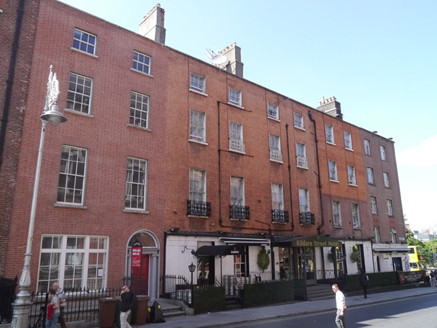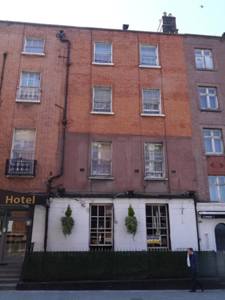Survey Data
Reg No
50100101
Rating
Regional
Categories of Special Interest
Architectural
Original Use
House
In Use As
Hotel
Date
1800 - 1820
Coordinates
316289, 233815
Date Recorded
31/05/2016
Date Updated
--/--/--
Description
Attached two-bay four-storey former house over basement, built c. 1810, with later full-height rear return. Now in use as part of hotel. M-profile slate roof, hipped to south end and gabled to north, having brick parapet with masonry coping; brick chimneystacks to north having clay pots; parapet gutters and cast-iron and replacement uPVC downpipes. Flemish bond machine-made red brick walling, first floor refaced in pink brick, painted ashlar stone walling to ground floor, and painted smooth rendered walls to basement. Yellow brick walling to rear and return. Square-headed window openings, diminishing to upper floors, with patent reveals and masonry sills, continuous to ground floor. Windows to upper floors are replacement one-over-one pane timber sliding sash with horns and recent secondary glazing fixed behind, and ground floor windows are six-over-six pane with simple horns and historic glass. Former window opening to north side of basement infilled. Access through recent entrance to adjoining building. Basement area partially covered with recent addition, with stepped access from north end, replacement metal railings with spearheaded finials and replacement painted masonry plinth.
Appraisal
A late Georgian house, likely built as part of a terrace with those to the south, and now forming part of a hotel and internally linked with Nos. 47-48. Although it has suffered substantial alteration and modification, it has retained the proportions and massing typical of the period and makes a contribution to the historic character of Kildare Street. Formerly called Coote Lane, this street was widened and renamed after 1745, when work on Leinster House began. Many houses in Kildare Street were built in the mid-1750s by John and George Ensor. While No. 49 appears to have been a later construction, the mid-eighteenth-century house may have been simply remodelled.



